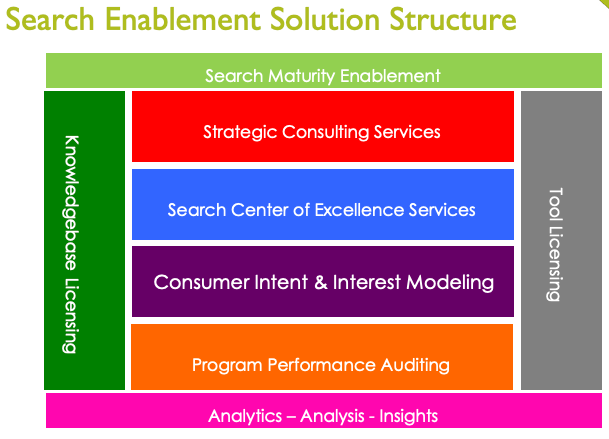While working with an agency to enhance their effectiveness with enterprise organizations, I guided them through the Search Maturity Framework that we developed at GSI. I introduced it as part of my epiphany series – as Epiphany 10. A Search Maturity Lifecycle (SML)—a framework we created to help companies evolve from running disconnected SEO and PPC projects to build the infrastructure and process necessary to move tactical search to a strategic, mission-critical business function.
But recognizing the lifecycle was only the beginning. The real value came in building the scaffolding to move companies up the curve. That scaffolding is what we call Search Maturity Enablement.
What Is Search Maturity Enablement?
Search Maturity Enablement is not a one-size-fits-all program. It’s a tailored, strategic approach to elevate a company’s internal search marketing capabilities—from disjointed execution to full organizational integration. It was the meta-service above all others: the mission that guided every engagement.
Our goal was simple: to build world-class search organizations. To architect the people, processes, tools, and governance structures that would turn search from a marketing project into a permanent source of competitive advantage.
The Service Stack that Powered Search Maturity

We offered a suite of services, each aligned with the organization’s current stage on its maturity journey.
Strategic Consulting Services
Guided business case development, aligned KPIs to growth outcomes, and advised executives on prioritizing search across global portfolios.
Search Center of Excellence Consulting
Built internal operating models and governance structures to scale search efficiently and reduce duplication and waste across markets.
Consumer Intent and Interest Modeling
Mapped high-value audience demand across the buyer journey and aligned it to content architecture, advertising, and measurement.
Program Performance Auditing
Diagnosed underperformance, uncovered execution gaps, and created playbooks to get results back on track—fast.
Analytics → Analysis → Insights
Moved clients from “reporting” to “decision-making” and “insights” by building insight pipelines and ensuring teams could act on what the data showed.
These services were bookended by:
- Knowledgebase Licensing – a customized, dynamic repository of search best practices tailored to each client’s platforms and business structure
- Tool Licensing – proprietary software like PLP Management, ShelfSpace Monitoring, and Consumer Interest Modeling to operationalize insights and streamline execution
Moving Up the Search Maturity Lifecycle
Let’s revisit the Search Maturity Lifecycle (SML) through the lens of Search Maturity Enablement.
Each phase represented a set of capabilities, constraints, and opportunities. Our job was to help companies navigate that journey, with the right services, tools, and mindset for each stage.
Phase 1: Functional – Project Specific and Proving Search Has Value
- Typical Spend: $5k – $75k
- Pain Point: No visibility for critical terms; underperforming brand pages; dropped from the index, or some other specific issue
- Engagement Model: Fixed-bid projects with limited scope
- Client Mindset: “Let’s just try something.”
- Our Focus: Quick wins through root cause and diagnostic consulting, rankings improvement
- Tools: Analytics; first-gen PLP; ShelfSpace v1
- Goal: Prove ROI, build internal credibility, and earn a license to expand
Phase 2: Tactical – Gaining Ground Across the Business
- Typical Spend: $250k – $500k
- Pain Point: Inconsistent performance across brands and BUs; lack of internal knowledge
- Engagement Model: Mix of internal and external resources; more education
- Client Mindset: “We need this to work across teams.”
- Our Focus: Build shared frameworks, training, and taxonomy; introduce governance
- Tools: PLP v2, SEMD, Value Metrics
- Goal: Operationalize SEO and PPC; position for centralized control
Phase 3: Integrated – Centralization and Efficiency
- Typical Spend: $500k – $1.5M
- Pain Point: Growth bottlenecks, Excel chaos, redundant campaigns
- Engagement Model: Central team + agency partners; regional execution
- Client Mindset: “This needs to scale without breaking.”
- Our Focus: Build Centers of Excellence, connect search to global campaigns, model ROI
- Tools: Full tech stack with insight dashboards and structured workflows
- Goal: Efficiency, closed-loop reporting, alignment with media and content teams
Phase 4: Global & Strategic – Search as a Core Business Driver
- Typical Spend: $1.25M – $1.5M+
- Pain Point: Complex multinational integration; channel conflicts; OEM coordination
- Engagement Model: Fully integrated global partnerships
- Client Mindset: “Search is mission-critical.”
- Our Focus: Global governance, partner enablement, advanced modeling, and gain-share
- Tools: Customized platform integrations, predictive analytics
- Goal: Enterprise search as a competitive advantage; integrated across all 360° channels
From Tactics to Transformation: Why It Worked
This model didn’t just help companies “do SEO better.” It helped them:
- Break down silos between teams and regions
- See the connective tissue between search, media, and brand
- Drive adoption of tools and processes across the organization
- Unlock new revenue streams and reduce operational waste
- Elevate search as a respected strategic function
That’s why we were often called the “McKinsey of Search.” We weren’t just an agency or a tool vendor—we were change agents for digital maturity. In many cases, we were asked to extend this model into other forms of digital marketing.
Search Maturity Is a Journey—We Built the Map
Every organization is somewhere on the Search Maturity Lifecycle. But most don’t know where they are—or how to move forward.
Search Maturity Enablement is how we built that roadmap. It’s how we helped companies go from reactive projects to proactive, integrated, and revenue-generating search operations.
And in the age of AI, fragmented visibility, and cross-platform intent, this kind of enablement is more urgent than ever.
